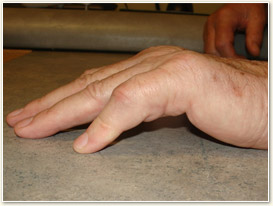The Hand & Wrist Center
3633 Long Beach Boulevard, Suite 100
Long Beach, CA 90807
Phone: (562) 424-9000
Monday - Friday: 8:00 a.m.–5:00 p.m.
Dupuytren’s Contracture Symptoms & Signs
The presence of Dupuytren’s Disease may not be known to an individual until it is discovered that they experience difficulty placing their hand flat on an even surface, such as a table top (see Figure 4). Additionally, some people notice increasing difficulty with activities such as washing, wearing gloves, shaking hands, and putting their hands into their pockets.

Figure 4: Dr. Nathan’s picture of a tabletop test
Initial symptoms of Dupuytren’s Contracture usually include the development of a small nodule, or lump, on the palmar surface of the hand or fingers. Some individuals may only develop small lumps or cords, while others will develop severely bent, curved fingers. Often, these nodules, or lumps, are mistaken for calluses because they are generally firm and adhere to the skin.
As Dupuytren’s progresses, the nodules appear to grow together to form a line in the palm or digit. This line is referred to as a “cord.” These cords, which commonly are mistaken for tendons, actually lie between the skin layer and the tendons. In many cases, cords occur most commonly in line with the Ring and Little fingers; however, contractures can occur in any of the digits in both hands. Similarly to Dupuytren’s Disease, nodules, lumps, and/or cords can occur in the soles of the feet (Ledderhose’s Disease), and in male genitalia (Peyronie’s Disease).
Dupuytren’s Disease is not typically painful, although when hand nodules initially develop they may be tender. Over time, several nodules may occur, progress and/or seize in development. Unfortunately, the degree of involvement and progression may vary and is mostly always unpredictable.
To learn more about Dupuytren’s Contracture and the various treatments to correct it, request a consultation, or contact The Hand & Wrist Center at (562) 424-9000.
Back to Top